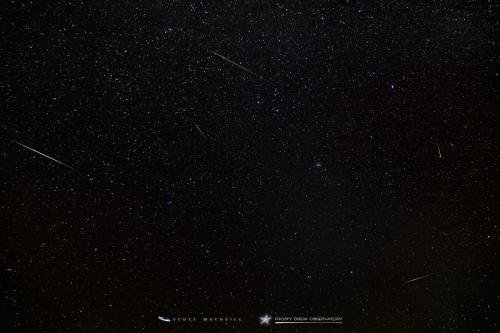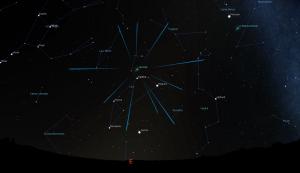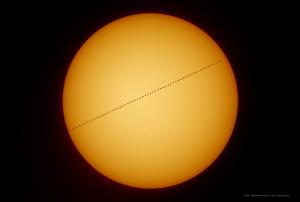Celebration of Space - November 15, 2019
This weekend, the peak of the annual Leonid Meteor Shower will occur. Happening overnight Saturday-Sunday, November 16-17th the Leonids usually bring an increase in regular meteor activity by an additional 15 meteors per hour. Though this year we will have the 80% waning gibbous Moon during the best times to see the shower, which will outshine all but the brightest meteors. The Leonid shower, which is rather slow going, is one of the showers that everybody knows of and generally considers a fabulous shower somewhat erroneously. The Leonids claim to fame is that the shower explodes with thousands of meteors per hour during the peak night on a 30 year interval. The last time this happened was in 2001, and everybody has heard the stories about that night of thousands of meteors. Though outside of that 30 year interval, the shower is rather beat. For example, in previous years at Frosty Drew Observatory we have observed more Taurid meteors during the Leonid peak than actual Leonid meteors. The next Leonid shower to impress will happen in 2031, though it is not predicted to be thousands per hour, like the 2001 Leonids, but it could bring similar displays as the Geminid or the Perseid meteor shower peaks.
Leonid meteors will radiate from the constellation Leo, around the center of the lion’s mane, in between the bright stars Algieba and Algenubi, which is considered the radiant point of the shower. Though Leonid meteors originate from comet 55P/Tempel-Tuttle, a periodic comet with an orbital period of 33 years. The orbital path of comet Tempel-Tuttle intersects Earth’s orbit around the Sun. Every November, Earth passes through a debris field left behind by the comet, mainly consisting of tiny dust-sized – rice grain-sized pieces of ice. These particles are captured by Earth’s gravity and enter Earth’s atmosphere at rates of 44 miles per second. At these speeds, the paticles burn up as they streak across the sky. If setting out to observe the Leonid shower, the morning hours after midnight will be the best times to be out. Lay on your back so you can look to the zenith (top of sky) comfortably. Additionally, set yourself up in a way where you block the Moon with a structure or other object to help minimize how much moonlight you are directly seeing. Happy meteor watching!
This past Monday, November 11, 2019, a fabulous Transit of Mercury took place. This happens when Mercury visibly passes in between the Earth and the Sun. Though Mercury is quite small, so a view through a telescope or binoculars is generally required to actually see it. At Frosty Drew Observatory we hosted an event for the entire transit, which lasted about five and a half hours. We had a threat of clouds, which totally worked out to our advantage as the Sun stayed out of the clouds until about 15 minutes before the end of the event. Hundreds of visitors came out to celebrate the transit with us under the Sun. Additionally, we were able to archive nearly the entire event on 20 second interval, and have been posting images, as we process them, to our Transit of Mercury 2019 gallery on our website. The next transit of Mercury that is visible over New England will happen in May 2049. For now, check out our gallery of the transit, and gear up for 2049.
It’s that time of the year again. The time when we start to think about holiday revelries, warm time with friends, fabulous drinks, and gaining that extra weight to help us through the winter (the optimists interpretation). It is also the time when we start to think about gift giving and where our generosity can make the biggest difference in our lives or the lives of those we love / respect. One such place on my list is the Frosty Drew Observatory. It is a place that brings so much happiness, escape, inspiration, and hope to so many people throughout the year. It is a place that is loved by countless awesome people and has served as a unique and fabulous addition to the larger Rhode Island and Southern New England community. Frosty Drew Observatory is a 501 (c)(3) non-profit organization and is funded by donations from those who love and support it. These donations are critical to our survival and for the execution of our mission to enlighten, discover, inspire- through education and research- knowledge about science, the night sky, and the universe. The entire Frosty Drew Observatory team, the individuals that inspire you with their knowledge and enthusiasm, that make you laugh, gasp with excitement, and even cry at the remarkable beauty of the cosmos; all operate on a volunteer basis and donate their time, endlessly, to make a positive difference in your life. As we kick off this time of giving, please consider making a gift to the Frosty Drew Observatory. Your support means the world to us and we are awesome because of you!
-Scott
- Author:
- Scott MacNeill
- Entry Date:
- Nov 15, 2019
- Published Under:
- Scott MacNeill's Columns





